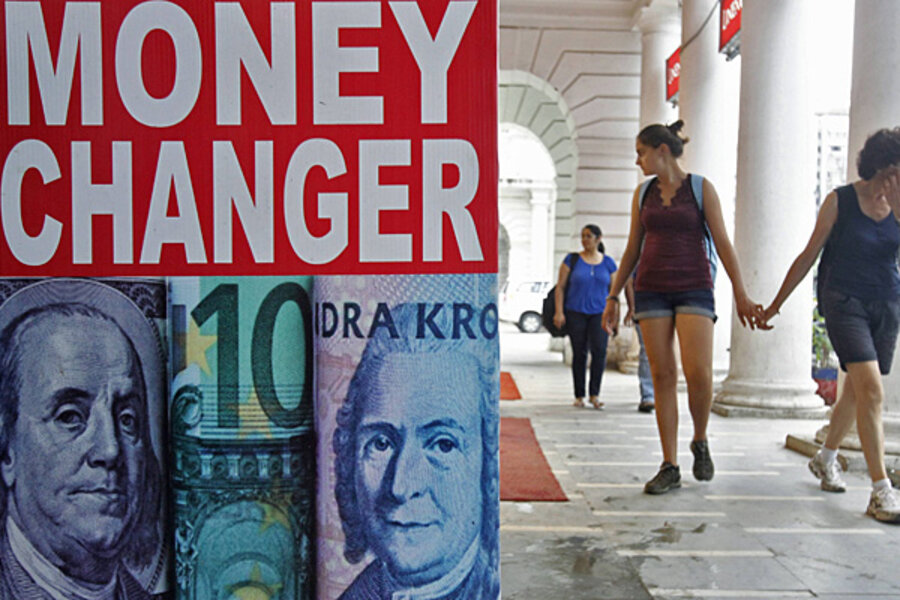Indian rupee hits record low
| Mumbai
The Indian rupee fell past 64 to the dollar for the first time on Tuesday and bond yields spiked to a five-year high before the central bank stepped in to sell dollars, as Asia's third-largest economy bore the brunt of the global emerging markets selloff.
Underscoring how hard it is for New Delhi to push through reforms despite the urgency of a deteriorating economic outlook, parliament was adjourned on Tuesday due to protests by members over a corruption scandal.
India's notoriously dysfunctional lower house of parliament was due to debate a bill to allow foreign investment in the fledgling private pension industry, a reform seen as key to government efforts to attract investment and narrow the current account deficit, which is exacerbating the currency crisis.
"India's problems are nowhere near resolution because New Delhi has not done anything - there is no focus on improving productivity, infrastructure or getting FDI (foreign direct investment) back," said Nomura credit analyst Pradeep Mohinani in Hong Kong.
"It's all about stemming the flow of currency and that is not the cause of the problem," he said.
Later on Tuesday, India was due to hold a $9.3 billion sale of government debt quotas, a gauge of foreign investor interest in local assets. Bankers said that the debt limits at the auction may get taken up, but at rock-bottom prices.
Foreigners have unloaded about $10 billion in Indian debt since May 22, when the U.S. Federal Reserve first signaled its intention to begin scaling back its quantitative easing. They now hold only 43 percent of the $30 billion limit available to them in Indian government debt.
The rupee slumped as much as 1.6 percent to 64.13 to the dollar, adding to its 2.3 percent rout on Monday, before traders said the central bank was seen stepping in to sell dollars.
Later, the Reserve Bank of India was believed by traders to be selling dollars in the forward market, a move that helps it support the rupee without immediately expending its reserves.
Stocks extended declines, with the BSE Sensex index falling as much as 1.8 percent to a near-year low. JPMorgan downgraded Indian equities to "neutral" from "overweight", citing strains in the country's balance of payments, while Citi cut its Sensex target to 18,900 from 20,800.
Selling of dollars by the RBI helped the partially convertible rupee recover somewhat to 63.65 to the dollar.
Bond yields spiked to 9.48 percent, a level not seen since before the Lehman Brothers crisis in 2008 before stability in the rupee helped them recover. Yields were last down 19 basis points (bps) on the day at 9.04 percent.
BORROWING RATES RISING
A spate of measures by the central bank and government has failed to halt the rupee slide, with liquidity tightening measures aimed at making it harder to short the currency pushing up borrowing rates and battering corporate and investor sentiment.
State-run oil firms, the largest dollar buyers in the forex market, face a deterioration in credit quality if they have to share a higher burden of the country's fuel subsidies due to rising crude prices and a falling rupee, Moody's said.
Srei BNP Paribas, an equipment finance company, on Tuesday raised its benchmark lending rate by 50 basis points to 17.75 percent, citing a continued rise in borrowing costs. Several Indian banks have also raised lending rates in recent weeks.
"Our rate hike has become imperative to maintain the quality of our portfolio," D.K. Vyas, chief executive officer at SREI BNP Paribas, said in a statement.
WEAK GOVERNMENT, WEAK ECONOMY
Prime Minister Manmohan Singh's weak coalition government, heading into national elections by next May, has been hamstrung from pushing through reforms to attract more long-term capital and close a record-high current account gap that has made India vulnerable to flows away from emerging markets.
Since Singh's government took office for a second term in 2009, the parliament has been the least productive in nearly three decades, according to PRS Legislative Research.
Instead, India has been limited to piecemeal measures such as Monday's move to increase the foreign direct investment cap in asset reconstruction companies to 74 percent from 49 percent, and a ban on the duty-free import of flat-screen TVs from Aug. 26.
The rupee's plunge also adds to worries about whether Finance Minister P. Chidambaram will be able to meet his goal to pare the fiscal deficit to 4.8 percent of gross domestic product (GDP) this fiscal year.
Rating agency Moody's said that while the rupee depreciation was a new variable for the economy, the factors underpinning it have been incorporated in its investment grade rating for India.
India is at the lowest investment-grade sovereign rating.
"We believe that meeting the fiscal deficit target will be very challenging this year, given lower than anticipated growth holding back revenue growth and steep rupee depreciation raising the subsidy bill on imported goods," analyst Atsi Sheth said in an e-mailed reply to queries from Reuters. ($1 = 62.9450 Indian rupees) (Additional reporting by Umesh Desai in HONG KONG, Archana Narayanan and Abhishek Vishnoi in MUMBAI, and Frank Jack Daniel in NEW DELHI; Editing by Tony Munroe & Kim Coghill)





